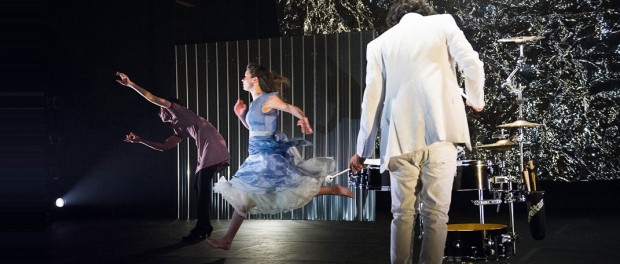The Others of Flamenco with La Otra Orilla
As with all traditional forms, there are those who relish in the craft of precise accuracy, and those who relish in the art of altered inspiration. La Otra Orilla has set up shop in the second camp, taking flamenco so far from its original strictures that some consider it unrecognizable. But does that matter? Not really. Once choosing the realm of abstraction and re-interpretation, the rules for assessing a form no longer apply in the same way. precision.
Myriam Allard and Hedi Graja’s latest production Moi&lesAutres is a spectacle. Four company members perform their hearts out in a highly visual, sensually charged show. If flamenco is the sea, then Allard and her group porpoise in and out of it, finding an arm movement, a rhythm, or a color to swim in, before rising to the sky for something completely unfamiliar. It is a delightful, playful variation that is wonderful to watch.
The first piece sets the stage that this is no ordinary flamenco show. There is a guitar, but that guitar appears as if horizontally floating in space. All is dark, save for the light on the guitar’s body. A single hand holds it in an unnatural way. From the darkness, a lithe musician, Caroline Planté, slithers in and adds a bars that begin to loop. She disappears and returns several times (as does the mysterious hand), adding to the original few bars until a full orchestration sounds through looping. To me, the magic of this piece comes from the fact it is being performed on a stage, live. This isn’t pre-recorded music, yet it looks like a music video. The haunting guitar, eerily brought to life by the musician. The music continues even when she leaves. This sets a dramatic, playful tone to the whole show. Expect nothing but wonder.

La Otra Orilla. Myriam Allard.
As lights came up and the stage revealed its simple set, two metal sheets, one crinkly, one corregated, and the dance begins. Flopped forward like a marionette hanging on a peg, Allard rises from her bent over position and moves her arms and legs in fragments of flamenco dance. The simplicity of the costume (striped, navy pants) and the set keeps attention on her, or more specifically, her silhouette. It is as if I am watching the negative space around her, almost as a shadow puppet, as much as I am watching her. As she is called off to a glowing yellow light from side stage, Graja comes to sing in his booming voice and a magnificent golden-russet toned coat. Who is he? The puppeteer? The Devil?
Our guitarist comes back seated in an office chair. The chair is pushed about on stage by two men who seem to fight for possession of her attention, though she remains focused on her playing. A metaphor, perhaps? Even as it spins, rocks, and threatens to tumble, she plays on, unfazed (what concentration and trust that must take because I felt anxious they would send her tumbling!). The arrival of Allard in a new costume and a red fan transforms the moment. The two men hold mikes over her head, as though trying to get the best shot for a television program shot in Italy in anytime from the 1920s-1950s.
In the final piece, the whole group comes together for what struck me as the most art school piece of the show. Graja recites a poem aloud in the back — an ode to his arms — Allard dances, one man drums, Planté runs back and forth in a dress the color of Alice in Wonderland blue. Planté leaps in to the arms of Graja, sending his papers flying, and the piece restarts again. After several rounds of this, the two couples begin to dance, finally melting into a group of four in a line that sways back and forth. It is… well… the most incoherent of the pieces and the least connected to the rest of the show save for the fact it uses all members of the company. I would have cut this, considering it a holdover from Homoblatusblablabla and the least internally coherent. It is really two separate pieces put together, and perhaps neither is strong enough on its own. To me, this is an artificial appendage to the rest of the show and a feeling of still being in process.

La Otra Orilla. Myriam Allard.
While this last piece doesn’t sit well with me, I still take pleasure in being pushed by art and encountering things that stretch what I find acceptable and fitting. Overall, I think this is one of the strengths of this company. Even if I don’t personally like the piece, it is in La Otra Orilla’s trademark style of experimentation, discomfort, and surprise.
If there is one thing I especially like about La Otra Orilla, it is the feeling that live performance is the only way to watch their shows. I don’t feel this for all dance, recognizing that a recorded performance could capture the experience. For Moi&LesAutres, the magic comes from seeing these things done live and having my attention pulled where the artists want me to look, like a magic show. No media would do for dissemination of their works, even though the works themselves suggest the forms of recorded media.
Moi&LesAutres is at Place des Arts until Feburary 6. $38/30. Tickets HERE.






